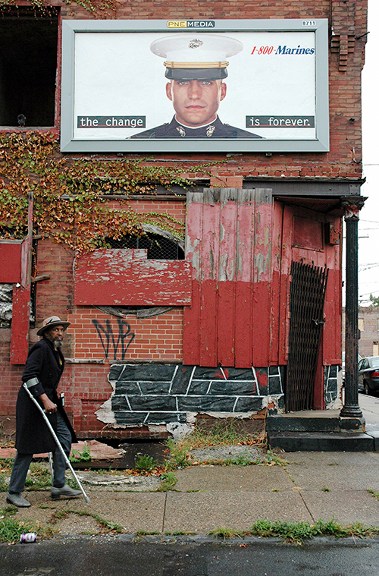Poverty Awareness Month: Zoe Strauss
Poverty Awareness Month evolved out of recognition by Congress in 2009 that the U.S. poverty rate is rising at an alarming level every decade. I doubt it is any coincidence that January was chosen as the month for this recognition, as it comes immediately following the most hedonistic, materialistic, and self-centered month of the year between Thanksgiving and Christmas. Poverty is not a recent problem, but it is not getting any better. I featured photographer Zoe Strauss in a post about Compassion in Art, and I think her story bears repeating during this awareness month.
 |
| Zoe Strauss (born 1970, U.S.), Marines Billboard, Philadelphia, 2004. Inkjet print, printed by Philadelphia Photo Arts Center, 12 3/16" x 8" (31 x 20.3 cm). Courtesy of the Philadelphia Museum of Art. © 2024 Zoe Strauss. |
During her first ten years of work, Strauss largely documented Philadelphia. Much like Diane Arbus (1923–1971), Strauss captures fleeting moments in the lives of people otherwise overlooked by society. Works by Arbus opened up a type of personal investigation into subjects that most people see on the street and ignore because it may not be “beautiful.” Strauss’ works address the same phenomenon. Her isolation of these often tragic figures gives their images a dignity and monumentality. Strauss strives to create an ongoing, epic narrative that documents the coexisting factors of beauty and struggle in everyday life.
Although Strauss’s subjects are not photographed as examples of the heroic, in essence, the honest gaze she captures reflects an everyday heroism overlooked by many artists. In Marines Billboard, Philadelphia, a photograph from the period of the wars in Iraq and Afghanistan, Strauss juxtaposed a disabled man in a poor Philadelphia neighborhood with a military advertisement. The billboard is a strident symbol of wars for which a lot of money is spent, instead of providing quality of life for those less fortunate.
The use of photography as social documentation was not a conscious movement until late in the 1800s, when Western countries were becoming rapidly industrialized and child labor, devastated urban spaces, and neglected rural communities became areas of concern. Reform groups in many countries began to address social issues. Because photography was considered most valuable as a document of visual fact, it was inevitable that the medium would be used to document social ills. However, social documentation was not characterized by random, unposed straight images. The photographers carefully composed their shots and chose just the right moment in order to imbue fact with feeling.
Strauss’s work is reflective of the sophisticated evolution of the Snapshot Aesthetic in the cause of social documentation. Although this photography style developed late in the 1800s, it flowered during the 1960s in the hands of many artists, including such standouts as Arbus and Garry Winogrand (1928–1984). The style mimicked the candid, unposed, spur-of-the-moment pictures taken by amateurs and middle-class families. Interestingly, between the 1960s and the 2000s, the style was refined to subtly reveal psychological investigation by the photographer.
Born in Philadelphia, Strauss received her first camera when she was 30. She began photographing the not-well-off areas of Philadelphia. Within ten years, she was documenting the compelling world of overlooked realities throughout the country. While largely self-taught, Strauss displays a sophisticated sense of composition in her work. She is particularly adept at suggestion and a monumental contrast of positive and negative space. Between 2001 and 2010, Strauss would hold yearly exhibitions of her work in the form of Inkjet prints that she sold for $5 in a makeshift “gallery” under the I-95 underpass in Philadelphia.
Correlations to Davis Programs: Experience Art: Unit 1; A Community Connection 2E: 1.1, 8.1; A Personal Journey 2E: 6.1; A Global Pursuit 2E: 1.1; Focus on Photography 2E: Chapter 6

Comments